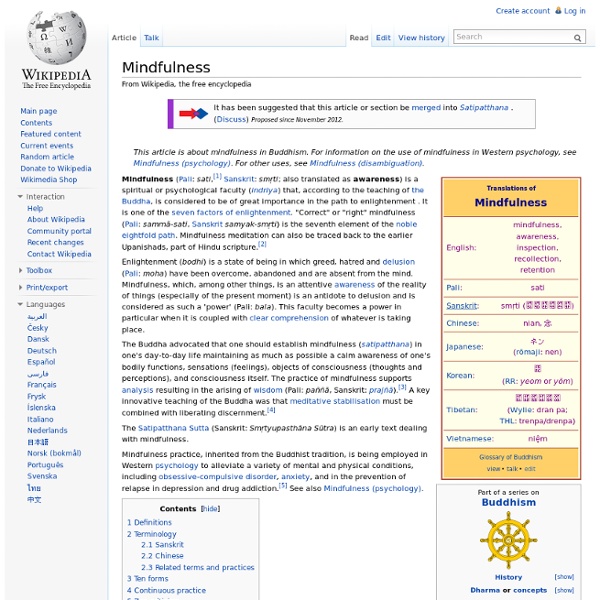3 Meditation Tricks to Help Keep You Present - Spirituality Blog on Balanced Life Center
Meditation, for me, is time dedicated to being present and aware of my oneness with God/Spirit/Consciousness. About 15% of the time I am able to drop into this zone and just buzz along. I come out of there in another world and everything hums along. The other 85% of the time I struggle with letting go of my plans, dreams, arguments, and task lists. I usually have a few tricks to sink into a meditative state. When focusing on my breath does not work, I think an affirmation. Another technique I use to still my mind is to watch my thoughts. Do you have any special ways to still your mind during prayer, meditation or throughout the day?
Defining Mindfulness
Mindfulness—where does it come from? Naturally, we hear this question a lot. We’ve addressed it on several occasions, including in a piece now online called “5 Things People Get Wrong about Mindfulness,” but it’s helpful to address core questions like this again and again. There is no final answer, no last word on the matter. The many mindfulness teachers and advocates who encouraged us to start Mindful—and whom we represent in everything we do—believe mindfulness is an inherent human capability that belongs to anyone irrespective of race, creed, gender, you name it. It is our birthright. What is it exactly? Since it’s a quality of mind, it’s not easy (or even desirable) to have a single, agreed-upon-by-everybody, one-size-fits-all definition. Mindfulness is the basic human ability to be fully present, aware of where we are and what we’re doing, and not overly reactive or overwhelmed by what’s going on around us. Concerning the question raised at the top—Where does it come from?
File:Rabbi Amar and Rabbi Metzger (29).JPG
Online Meditation Timer
Serotypes and the Importance of Serotyping Salmonella | Salmonella Atlas | Reports and Publications | Salmonella
Medical illustration of non-typhoidal Salmonella Serotypes are groups within a single species of microorganisms, such as bacteria or viruses, which share distinctive surface structures. For instance, Salmonella bacteria look alike under the microscope but can be separated into many serotypes based on two structures on their surface: The outermost portion of the bacteria’s surface covering, called the O antigen; andA slender threadlike structure, called the H antigen, that is part of the flagella. The O antigens are distinguished by their different chemical make-up. Different Serotypes Salmonella have many different serotypes. The bacteria’s surface are covered with lipopolysaccharide (LPS). Some groups of people, such as older adults, people with weakened immune systems, and children under five years old have a higher risk for Salmonella infection. More than 2,500 serotypes have been described for Salmonella; but, because they are rare, scientists know very little about most of them.
Guardia Sanframondi
Guardia Sanframondi is a town and comune in the Province of Benevento, Campania region, Italy. It is best known for the penitential rite held every seven years. Geography[edit] The town is dominated by a medieval castle. Penitential rite[edit] Guardia hosts a riti settennali di penitenza or penitential rite every seven years. Mysteries[edit] The four quarters of town each form committees to organize a parade of "mysteries" (religious scenes), with volunteers in period costumes from the Old Testament, New Testament, and Lives of Saints. Choirs[edit] Each quarter also forms a choir that joins the processions. Beater with "sponge." Penitents[edit] During the neighborhood processions, several flagellanti ("flagellants") join in. Additionally there are a few dozen symbolic child flagellanti. Madonna and Child procession. Statue[edit] The rite ends with the procession of the Madonna and Child statue through the town. Gallery[edit] Portico in the historic centre Notes and references[edit]
Serotype
From Wikipedia, the free encyclopedia Distinct variation within a species of bacteria or virus or among immune cells Serotyping often plays an essential role in determining species and subspecies. The Salmonella genus of bacteria, for example, has been determined to have over 2600 serotypes. Vibrio cholerae, the species of bacteria that causes cholera, has over 200 serotypes, based on cell antigens. Serotypes were discovered by the American microbiologist Rebecca Lancefield in 1933.[4] Role in organ transplantation[edit] The immune system is capable of discerning a cell as being 'self' or 'non-self' according to that cell's serotype. Human leukocyte antigens[edit] Serotyping of Salmonella[edit] See also[edit] References[edit] External links[edit] HLA Allele and Haplotype Frequency Database
GRĒKA SLIMĪBAS DZIEDINĀŠANA | Latvijas Luterānis
Pirmkārt, lai taptu dziedināts, tev jāzina, ka esi slims; un, otrkārt, tev jāzina, ka Kristus dziedināšanas būtība ir grēku piedošana. Apspriedīsim šīs divas atziņas, domājot par Bībelē aprakstītajām dziedināšanām. Svētie Raksti mums liecina par daudzām slimo dziedināšanām: tās veica senie pravieši, Kristus un Viņa apustuļi. Cilvēki cieš no slimībām. Īpaši no tām, kuras medicīna ārstēt nemāk, un tām, no kurām nav cerību izveseļoties. Ko mums par to domāt? Pasaule alkst pēc cilvēces mūžīgo problēmu atrisināšanas, cilvēki alkst pēc sensācijas. Es ceru, ka no šādas manas runāšanas jūs iztrūkstaties ne pa jokam! Līdzīgi tam Kristus baznīcai ir viens novirziens, viena kaite, ko tā ārstē visā plašajā cilvēka problēmu spektrā. Taču, lai cilvēki tiktu dziedināti, tiem sava slimība jāzina, jāpazīst tās simptomi, un jāzina, kur, kā, kad un pie kā ārstēties. Kādi ir grēka slimības simptomi? Dažādas slimības izraisa dažādas sāpes. Bet kā ir grēka slimības gadījumā? Gundars Bākulis
Social Categorization - Oxford Research Encyclopedia of Psychology
Craig McGarty Department of Psychology, Western Sydney University Access to the complete content on Oxford Research Encyclopedia of Psychology requires a subscription or purchase. Public users are able to search the site and view the abstracts and keywords for each book and chapter without a subscription.
Ghazal Radio | playing ghazals 24 hours
Self-categorization theory
Theory in social psychology Aspects of the theory[edit] Levels of abstraction[edit] Accentuation[edit] Depersonalization and self-stereotyping[edit] Determinants of categorization[edit] Perceiver readiness[edit] Comparative fit[edit] Normative fit[edit] Online category formation[edit] Prototypicality[edit] Implications[edit] Social influence[edit] Out-group homogeneity[edit] Controversies[edit] [edit] Category hierarchies[edit] Motivation in the theory[edit] References[edit]



